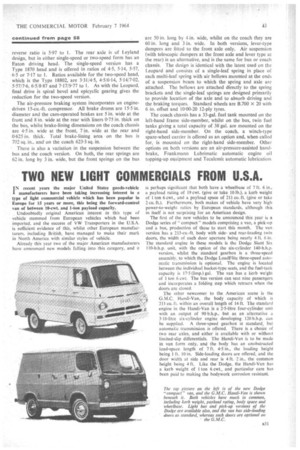TWO NEW LIGHT COMMERCIALS FROM U.S.A.
Page 65

If you've noticed an error in this article please click here to report it so we can fix it.
IN recent years the major United States goods-vehicle I manufacturers have been taking increasing interest in a type of light commercial vehicle which has been popular in Europa for 15 years or more, this being the forward-control van of between 10-cwt. and 1-ton payload capacity.
Undoubtedly original American interest in this type of vehicle stemmed from European vehicles which had been imported, and the success of VW Transporters in the U.S.A. is sufficient evidence of this, whilst other European manufacturers, including British, have managed to make their mark in North America with similar styles of vehicle.
Already this year two of the major American manufacturers have announced new models falling into this category, and it
is perhaps significant that both have a wheelbase of 7 ft. 6 in., a payload rating of 19 cwt. (give or take 10 lb.), a kerb weight of 1 ton 6 cwt., and a payload space of 211 cu. ft. (give or take 2 cu. ft.). Furthermore, both makes of vehicle have very high power-to-weight ratios by European standards, although this in itself is not surprising for an American design.
The first of the new vehicles to be announced this year is a Dodge series of " compact" models comprising a van, a pick-up and a bus, production of these to start this month. The van version has a 213-cu.-ft, body with sideand rear-loading twin doors, the width of each door aperture being nearly 4 ft. 6 in. The standard engine in these models is the Dodge Slant Six I l0-b.h.p. unit, with the option of the six-cylinder 140-b.h.p. version, whilst the standard gearbox is a three-speed assembly, to which the Dodge LoadFlite three-speed automatic transmission is optional. The engine is located between the individual bucket-type seats, and the fuel-tank capacity is 17-5 (Imp.) gal. The van has a kerb weight of 1 ton 6 cwt. The bus version can seat nine passengers and incorporates a folding step which retracts when the doors are closed.
The other newcomer to the American scene is the G.M.C. Handi-Van, the body capacity of which is 211 Cu. ft. within an overall length of 14 ft. The standard engine in the Handi-Van is a 2-5-litre four-cylinder unit with an output of 90 b.h.p., but as an alternative a 3.18-litre six-cylinder engine developing 120 b.h.p, can be supplied. A three-speed gearbox is: standard, but automatic transmission is offered. There is a choice of two rear axles, and either is available with or without limited-slip differentials. The Handi-Van is to be made in van form only, and the body has an unobstructed load-space length of 7 ft. 4-5 in., the loading height being 1 ft. 10 in. Side-loading doors are offered, and the door width at side and rear is 4 ft. -2 in., the common height being 4 ft. Like the Dodge, the Handi-Van has a kerb weight of 1 ton 6 cwt., and particular care has been paid to making the bodywork corrosion resistant.




















































































































